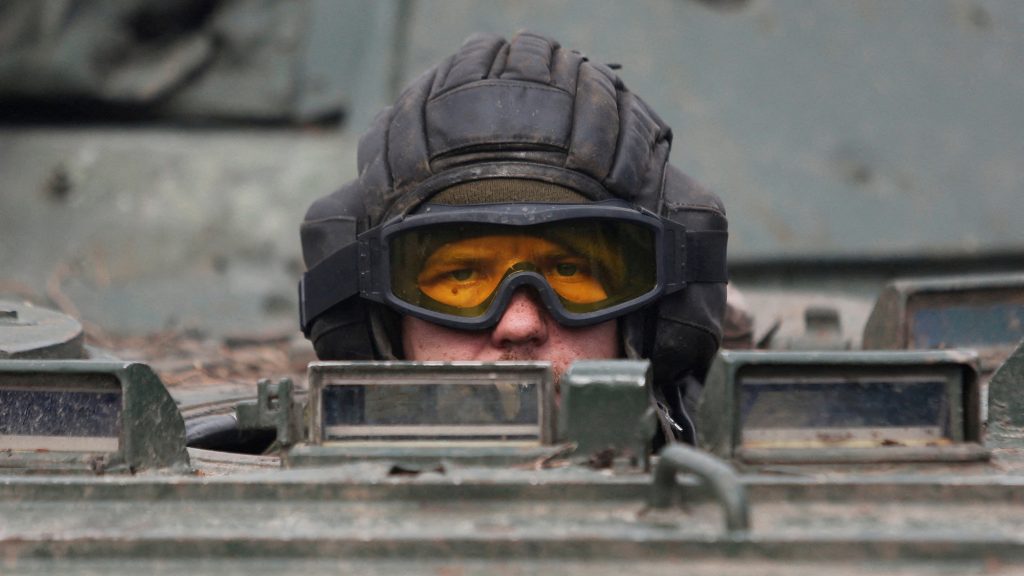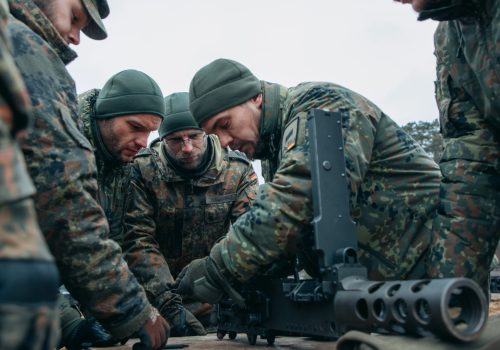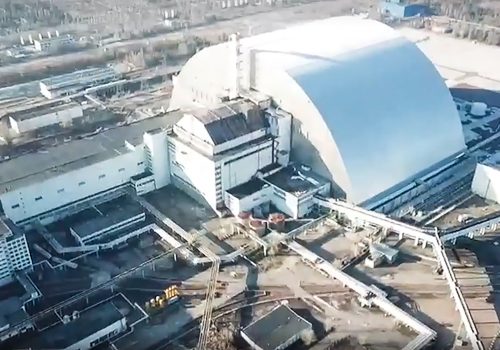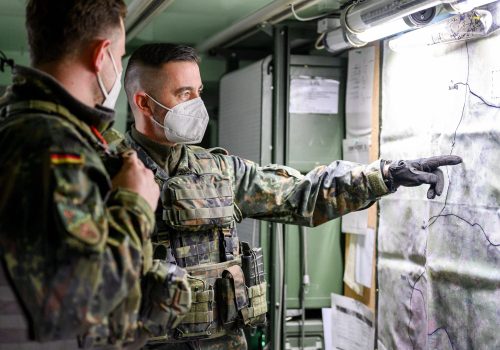In light of the ongoing Russia crisis, the Scowcroft Center’s Forward Defense (FD) practice will share weekly assessments of the latest force developments surrounding Ukraine, leveraging the expert perspectives of our senior military fellows. The opinions, conclusions, and recommendations expressed or implied here are solely those of the authors and do not represent the views of the Department of Defense or any other US government agency.
The bottom line
After two weeks of fighting, Russia’s own force miscalculations and fierce Ukrainian opposition have dashed the Kremlin’s hopes of a lightning victory over Ukraine. This week, we anticipate another Russian offensive against Kyiv which would heavily rely on artillery and air strikes targeting Ukrainian forces—but with little regard for civilian casualties and collateral damage. The fight for air superiority remains highly contested, with unanticipated Russian Air Force losses. Neither Russia nor Ukraine is likely to gain air superiority over the next week, and we expect high attrition of Russian attack aircraft and helicopters to continue as Russia attempts to support its ground forces. Meanwhile, Russian forces are enjoying much greater success in the south, where they are close to solidifying a land bridge from the Crimean Peninsula to the Donbas region. We predict Russia will carry out a major attack on Odesa, leveraging a small amphibious operation used to reinforce ground forces with additional personnel and ground-based fire systems and augmented by air and missile strikes against Ukrainian positions. Furthermore, we assess that Russian President Vladimir Putin will maintain, if not increase, his tacit or explicit threats of nuclear escalation.
Russian military progress
Air and air defense: Russia has still failed to establish air superiority and is consequentially suffering huge aircraft losses. Nevertheless, it is noticeably increasing the tempo of air operations, primarily focusing on ground attack and close air support. It is highly unlikely that either side will establish air superiority over Kyiv in the coming week.
- Suffering unsustainable loss of aircraft and helicopters. According to the Ukrainian Ministry of Defense (MoD), Russia lost forty-eight planes, eighty helicopters, and seven unmanned aerial vehicles during the first two weeks of the war—which already exceeds the total number of aircraft the US-led coalition lost in the entirety of Desert Storm. Though all Ukrainian kill claims cannot be independently verified, numerous photos and videos confirm Russian aircraft losses. We believe that the root cause continues to be the Kremlin’s failure to secure even localized air superiority over Kyiv.
- Renewed focus on suppression of enemy air defenses (SEAD). Russia released a video on March 7 demonstrating its most advanced fighter involved in the war, the Su-35S Flanker—carrying the Kh-31P anti-radiation missile, an air-to-surface projectile that homes in on radar energy. This leads us to believe that Russia is placing increased emphasis on the SEAD mission and that Russian air tactics are changing due to high losses and the threat of Ukrainian surface-to-air missile (SAM) systems. During the next week, we expect a focus on airfield attacks and attempts to seek and destroy mobile SAMs. But due to Russia’s poor SEAD doctrine, training, and tactics, these potentially forthcoming attacks on Ukrainian SAMs are likely to be only marginally effective in contrast to the deadly threat posed by such systems to Russian aircraft.
- Renewed focus on airfield attacks. While Russia attacked Ukrainian military airfields on the first night of its campaign, it failed to crater runways or destroy the preponderance of Ukrainian aircraft on the ground. In our eyes, this failure encouraged the Ukrainian Air Force to continue fighting. Over the past few days, Russia has put a renewed emphasis on attacking military and dual-use airfields and conducting devastating missile attacks. We expect it will continue such attacks with stand-off, precision-guided munitions in an effort to destroy Ukrainian aircraft and prevent them from mounting sustained airborne resistance to Russian air attacks.
- What did we get wrong about Russian air superiority? Prior to the invasion, we assessed that Russia would establish air superiority within seventy-two hours of conflict. This has clearly not materialized. Here is what we got wrong:
- Failure of initial strikes. Russian air and missile strikes at the start of the conflict failed to inflict serious damage on Ukrainian air defenses, and the Russians have struggled with that error for two weeks now. They failed to mass kinetic and non-kinetic fires against air-surveillance radars, critical integrated air defense system (IADS) command and control (C2) nodes, and on SAMs and aircraft. The initial wave of strikes in any conflict is usually the most destructive (since there is at least a measure of surprise), and well-placed strikes can add to the early fog and friction by blinding the adversary and cutting off its means of communication. Russia failed to do that. As a result, the Ukrainian IADS appears to be operational and is detecting, identifying, and passing Russian targets to Ukrainian shooters, contributing to the high Russian losses.
- Failure to change tactics in the face of huge losses. Despite losing large numbers of planes and helicopters, Russia did not change tactics to make the hunting and killing of SAMs, and the destruction of aircraft, on the ground a priority until at least ten days into the conflict. As a result, Ukrainian SAMs continue to engage Russian combat fighters, while Ukrainian fighter aircraft continue to contest control of the skies. Additionally, whether because of depleted stockpiles of stand-off, precision-guided munitions, an unwillingness to use those weapons, or tactics that favor low altitude attacks with unguided munitions, Russian fighters and helicopters have operated at low altitude, where they are much more susceptible to Ukrainian air defenses, specifically by man-portable air defense systems (MANPADS) such as the US-supplied Stinger.
- Poor “force packaging.” Air campaigns are most effective when they include the massing of combat power and are augmented by critical combat enabling capabilities, which is known as “force packaging.” Generally, an air campaign will include aircraft focused on air superiority, SEAD, strategic attack (on critical governmental and military targets), and ground attack (on adversary military forces, reinforcements, and resupply). These aircraft will be supported by airborne and ground-based C2 platforms; airborne, surface, and space-based intelligence, surveillance, and reconnaissance (ISR) platforms; and airborne and ground-based electronic warfare platforms. There is no evidence that Russia has built a force package of this type at any point in the conflict, raising the question of whether this is a doctrinal, training, and/or planning failure. Regardless of where the failure(s) lie, the lack of force packaging means that Russia has not massed airborne fires against critical Ukrainian targets, thereby limiting its lethality while also eroding the survivability of its aircraft.
Nuclear-capable forces: This past week, Russia moved toward substantiating Putin’s declaration of a “special regime of combat duty” by exercising its ballistic missile submarines (SSBNs) and land-mobile intercontinental ballistic missiles (ICBMs). Still, as we assessed late last week, these moves fall short of a full nuclear mobilization by Russia. At this stage of the conflict, Russian strategy remains centered on using nuclear threats to deter direct US or NATO intervention in the war, as well as making escalatory statements to dissuade the United States, NATO, and the West from providing further support to Ukraine.
- Nuclear drills in the Barents Sea and Irkutsk Region. After raising the alert of Russian nuclear forces, Putin ordered two nuclear drills. On the Kola Peninsula near Finland, SSBNs were involved in drills to “train maneuvering in stormy conditions.” Meanwhile, units of the Strategic Missile Forces dispersed RS-24 Yars launchers—road-mobile ICBMs—in the Irkutsk region of eastern Siberia to practice secret deployments. While these developments might be concerning, they were temporary and fall short of a full nuclear mobilization.
- Raising the risk of nuclear disaster of another kind. Russian forces carried out conventional military assaults against several of Ukraine’s nuclear power plants. Last Thursday, Russian and Ukrainian forces battled around the Zaporizhzhia nuclear plant, where Russian shelling set a building on fire (it was later contained). Russian forces have captured the power plant, and there are reports of nuclear engineers being forced to work at gunpoint. According to the Ukrainian state nuclear power regulator, the reactors themselves were not damaged and there was no release of radiation. The director-general of the International Atomic Energy Agency nonetheless stated that he was “gravely concerned” and that, to avoid disaster, no fighting around nuclear power plants should ever take place.
- Russia could be intentionally manipulating the risk of nuclear disaster. It is unclear to us why Russia is risking a nuclear disaster by fighting near nuclear power plants. On one hand, they are strategic targets, providing half of Ukraine’s power generation, and, if Russia intends to control the power supply in Ukraine, it must control nuclear power plants. On the other hand, this could be intended as a warning: Moscow might be signaling that it is willing to risk a nuclear disaster to coerce the Ukrainians into not defending the plants. A sort of nuclear brinkmanship, this could be intended to force NATO members and other European backers of Ukraine to understand that their support could lead to a nuclear disaster with ramifications for the entire continent. These explanations are not mutually exclusive and, no matter the reason, to fight near a nuclear power plant still creates an extreme risk of accident and disaster.
- As the invasion continues, don’t expect Russia’s behavior to change. Intentionally attacking nuclear power plants is in violation of Protocol I of the Geneva Convention, from which Russia withdrew in 2019. Russia’s attack faced international condemnation, with the US Ambassador to the UN and others calling the move “reckless.” Still, attacks like these may continue. As Russian forces continue to advance northwest out of Crimea, they appear to be moving toward the South Ukraine Nuclear Power Plant in the Mykolaiv region, just north of Odesa.
Ground forces: Russia appears committed to defeating Ukraine, no matter the costs. Its tactics, which are more closely associated with World War II-era conflicts, resemble unlimited war. Russia’s disregard for casualties—both its own and those of Ukrainian civilians—is uncharacteristic of modern warfare. Still, Russia holds the overwhelming combat power advantages that will eventually grind down Ukraine.
- Siege warfare. Russia is widely employing siege tactics that include indiscriminate bombing and cutting off resources to the military and the population. We expect Russia will continue escalation.
- Humanitarian corridors. It appears that Russia bluffed when it agreed to humanitarian corridors out of Mariupol and Volnovakha. It is not in Russia’s near-term interest to reduce suffering of the civilian population when its strategy is to force Ukraine to capitulate.
- Russian logistics improvements. The Russian Armed Forces have improved their logistics execution in the past week. The large convoy northwest of Kyiv is mainly packed with fuel, ammunition, and supplies, and there is a similar convoy now approaching Kyiv from the east. Given that Russia has slowed its advance to Kyiv, these convoys are likely in a hold pattern. Additionally, rail deliveries into Ukraine are now helping Russia sustain its forces with bulk supplies.
- Axes of advance. Russia will continue to exploit it success in the south, taking Mariupol and attacking toward Odesa, while continuing to advance to Kyiv from the north and the east. Over the next week, Russia will attempt cut the capital off and begin a brutal siege.
Subscribe to our weekly military assessment
Sign up for updates from Forward Defense to hear the latest on the trends, technologies, and military challenges shaping tomorrow.
US, allied, and partner deployments
This week, the United States announced it would send three hundred soldiers from the US Army’s V Corps to augment its headquarters (forward) in Poland. The US Army also announced deployments of a maintenance and an ordnance company to support 1st Brigade, 3rd Armored Brigade Combat Team. Approximately five thousand soldiers remain on high alert for potential deployment to Europe. We expect the Department of Defense (DoD) to factor in US responses to the Ukraine War as part of upcoming long-term force posture decisions.
Materiel supply to Ukraine. The United States and NATO are in talks to supply Polish MiG-29s to Ukraine. In exchange, the United States would supply Poland with additional F-16s. However, on March 7, Poland announced it was transferring its fleet of MiG-29s to the United States, who would then supply the aircraft to Ukraine. The next day, DoD press secretary John Kirby said he did not “believe Poland’s proposal is a tenable one.” It is unclear if the aircraft will be delivered to Ukraine. Meanwhile, NATO has redoubled its efforts to supply Javelin and Stinger missiles and has successfully delivered large amounts of each in the past week. Sea supply routes into Ukraine remain completely cut off, and aerial resupply remains severely restricted, but ground resupply routes remain open for now (mainly through Poland and Romania). We expect that Russia will attempt to interdict external resupply routes as they advance deeper into Ukraine, including through aerial and artillery bombardment, ambushes, and sabotage of rail lines.
FD’s conclusion
The Russian invasion of Ukraine has split into two major areas of operations (AO), each with varying objectives and degrees of success. In the northern AO, Russia’s ground-force push into Kyiv and Kharkiv has significantly slowed, with nearly all deployed Russian forces now committed to the invasion force. Both cities face the threat of being encircled, and Russia has begun to implement siege tactics, notably indiscriminate air and missile attacks and ground-based rocket and artillery fire. Over the coming week, we assess that this deadly harassing fire will escalate, but we do not believe an all-out assault of Kyiv is likely.
In the southern AO, Russia has been much more successful, with Russian forces having broken out of the Crimean Peninsula and created a land bridge to the Russian-occupied territories of the Donbas. Over the coming week, we anticipate that Russia will consolidate those gains and focus on the westward push of forces from Crimea toward Odesa and eventually the Russian-backed, Moldovan breakaway state of Transnistria (where it already has forces stationed, and reportedly was the origin of the missile strike on Vinnytsia airport in central-west Ukraine). Russian amphibious forces will likely land east of Odesa to avoid strong opposition, and Russia will use those troops and equipment to reinforce the ground invasion that will aim to take historic Odesa, Ukraine’s third-most-populous city. We assess that it could fall as early as next week.
The Russian air campaign has been a disaster: The Russian Air Force and ground defenses have failed to overwhelm the Ukrainian Air Force. Now two weeks into the conflict, Russia is not close to establishing air superiority over Kyiv or the country as a whole. Over the coming week, it will make a concerted effort to find and eliminate Ukrainian SAMs that have been taking a fearsome toll on the Russian Air Force, and the Kremlin will look to devastate the Ukrainian Air Force on the ground with frequent missile attacks against Ukrainian military airfields. But poor operational planning, tactics, and training make the success of these strikes unlikely, and Russia will very likely still be struggling to achieve air superiority at this time next week.
Meet the FD team
Today’s briefing is brought to you by senior US Army fellow COL Benjamin Johnson, senior US Air Force fellow Lt Col Tyson Wetzel, senior US Marine Corps fellow Col J.B. Barranco, FD assistant director Mark J. Massa, and FD project assistant Alyxandra Marine. The Scowcroft Center Military Fellows Program, housed by the Forward Defense practice, hosts military fellows from participating branches of the US military and the armed forces of US allies and partners each year as part of a twelve-month fellowship program.
Further reading
Tue, Mar 8, 2022
What are the risks and benefits of US/NATO military options in Ukraine? Our strategic risk calculator has answers.
The Big Story By Tyson Wetzel, Barry Pavel
A strategic risk calculator for policymakers on both sides of the Atlantic to assess the possible risks and benefits of boosting their military assistance to the Ukrainian government.
Wed, Mar 9, 2022
Russian War Report: Russia escalates nuclear and chemical false-flag allegations
New Atlanticist By
On March 9, Russia escalated their claims that Ukraine intended to use nuclear or biological weapons against Russia and that capturing nuclear power plants were to "prevent" such attempts.
Mon, Mar 7, 2022
A new era for NATO has begun
New Atlanticist By
On a political and on a military level, NATO is closer than ever—and readier than ever.
Image: A service member of pro-Russian troops drives an armoured vehicle in the separatist-controlled village of Bugas during Ukraine-Russia conflict in the Donetsk region, on Ukraine March 6, 2022. Photo via REUTERS/Alexandr Ermochenko.



